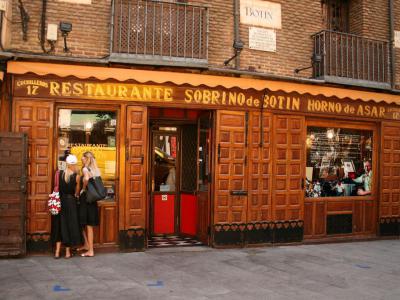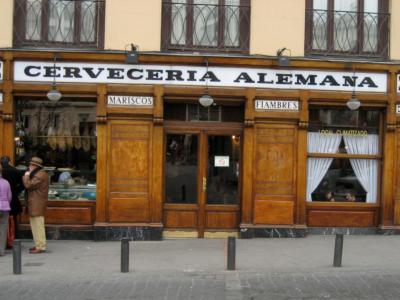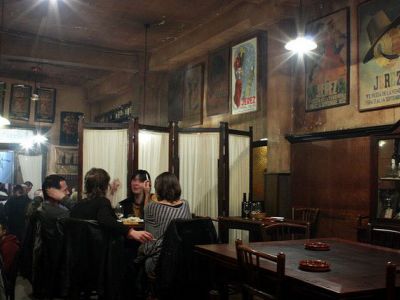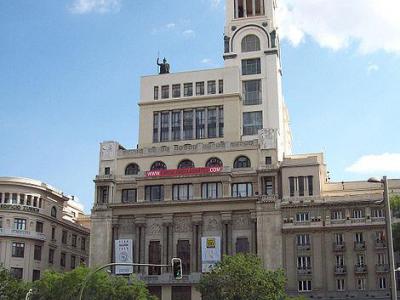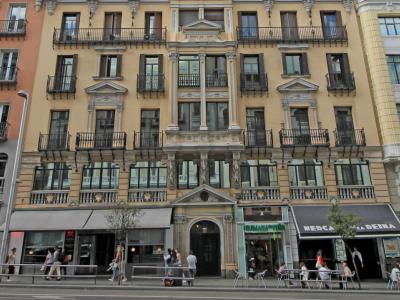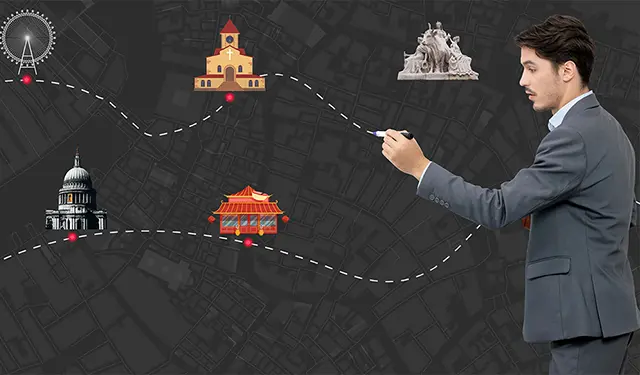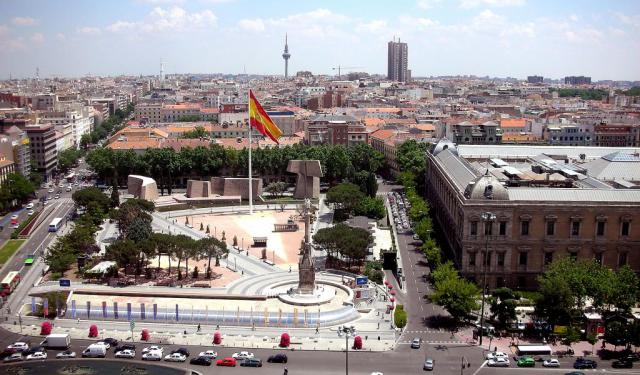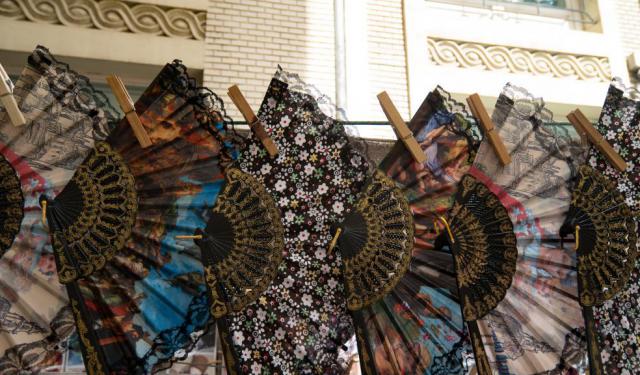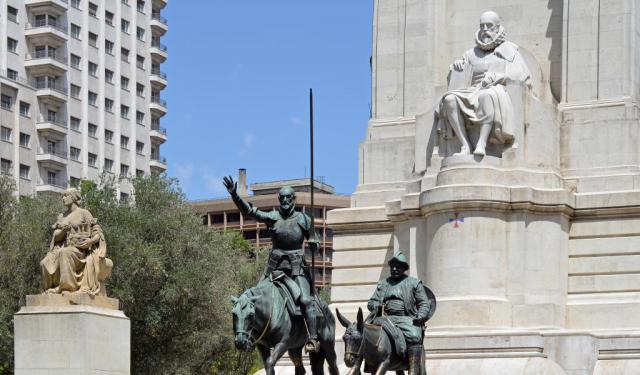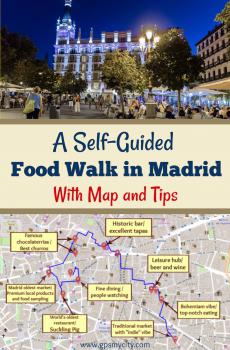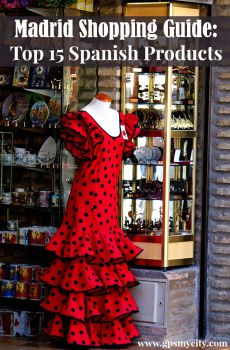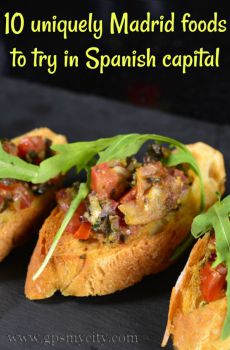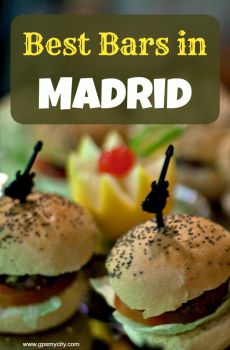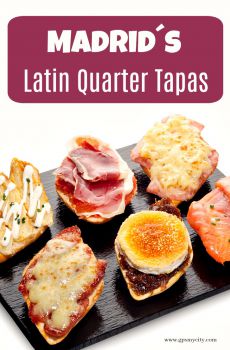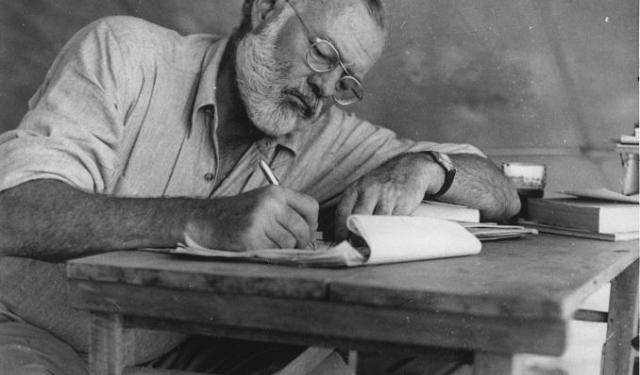
Ernest Hemingway's Madrid Walking Tour (Self Guided), Madrid
Among the many writers who’ve spoken fondly of Madrid, few did so as passionately—or as famously—as Ernest Hemingway. A giant of 20th-century literature, Hemingway penned classics like “The Sun Also Rises”, “Death in the Afternoon”, “The Fifth Column”, “For Whom the Bell Tolls”, and “The Old Man and the Sea”. But beyond his books, he had a deep, lasting connection with the Spanish capital.
It was here that he found inspiration, international acclaim, and a city he would return to time and time again. His love affair with Madrid began while covering the Spanish Civil War as a correspondent, calling it “the most Spanish of all cities”—a place that captured his imagination and spirit like no other.
To the locals, he was simply “Don Ernesto”, and quickly became a familiar face around town. As part of the foreign press, Hemingway had an office inside the Telefónica Building. He’d spend evenings at La Venencia, a bar frequented by Republican soldiers, gathering stories and sipping sherry. He was also a regular at the German Beerhouse—where, to this day, you can still sit at the same table he once occupied.
On this self-guided walking tour, you’ll get to follow in Hemingway’s footsteps—visiting some of his favorite spots, including the elegant Westin Palace Hotel, the historic restaurant El Sobrino de Botín, and other legendary hangouts.
So lace up your walking shoes, bring your curiosity, and join us as we explore the Madrid Hemingway loved—one stop at a time.
It was here that he found inspiration, international acclaim, and a city he would return to time and time again. His love affair with Madrid began while covering the Spanish Civil War as a correspondent, calling it “the most Spanish of all cities”—a place that captured his imagination and spirit like no other.
To the locals, he was simply “Don Ernesto”, and quickly became a familiar face around town. As part of the foreign press, Hemingway had an office inside the Telefónica Building. He’d spend evenings at La Venencia, a bar frequented by Republican soldiers, gathering stories and sipping sherry. He was also a regular at the German Beerhouse—where, to this day, you can still sit at the same table he once occupied.
On this self-guided walking tour, you’ll get to follow in Hemingway’s footsteps—visiting some of his favorite spots, including the elegant Westin Palace Hotel, the historic restaurant El Sobrino de Botín, and other legendary hangouts.
So lace up your walking shoes, bring your curiosity, and join us as we explore the Madrid Hemingway loved—one stop at a time.
How it works: Download the app "GPSmyCity: Walks in 1K+ Cities" from Apple App Store or Google Play Store to your mobile phone or tablet. The app turns your mobile device into a personal tour guide and its built-in GPS navigation functions guide you from one tour stop to next. The app works offline, so no data plan is needed when traveling abroad.
Ernest Hemingway's Madrid Walking Tour Map
Guide Name: Ernest Hemingway's Madrid Walking Tour
Guide Location: Spain » Madrid (See other walking tours in Madrid)
Guide Type: Self-guided Walking Tour (Sightseeing)
# of Attractions: 7
Tour Duration: 1 Hour(s)
Travel Distance: 2.5 Km or 1.6 Miles
Author: emma
Sight(s) Featured in This Guide:
Guide Location: Spain » Madrid (See other walking tours in Madrid)
Guide Type: Self-guided Walking Tour (Sightseeing)
# of Attractions: 7
Tour Duration: 1 Hour(s)
Travel Distance: 2.5 Km or 1.6 Miles
Author: emma
Sight(s) Featured in This Guide:
- Sobrino de Botin (Europe's Oldest Restaurant)
- Cerveceria Alemana (German Beerhouse)
- La Venencia
- Westin Palace Hotel
- Circulo de Bellas Artes (Circle of Fine Arts)
- Bar Museo Chicote (Chicote Bar Museum)
- Edificio Telefonica (Telefonica Building)
1) Sobrino de Botin (Europe's Oldest Restaurant) (must see)
Dating all the way back to 1725, Sobrino de Botín holds the title of Europe’s oldest continuously operating restaurant—as recognized by the Guinness Book of Records. Originally called Casa Botín, it was founded by a Frenchman named Jean Botín and his wife. In the beginning, it functioned more like a tavern than a restaurant. But after Mrs. Botín passed away, her nephew took over, and the name changed to Sobrino de Botín—which means “Botín’s Nephew” in Spanish.
Step inside, and you'll find yourself in a maze of cozy, rustic dining rooms, where centuries of history seem to linger in the air. Botín is especially famous for two signature dishes: “cochinillo”, or roast suckling pig, and “cordero lechal”, tender roast lamb. The recipes haven’t changed over the years, and believe it or not, the wood-fired oven has never gone cold—it’s been burning continuously for three centuries.
The restaurant has also seen its fair share of famous faces. The legendary Spanish painter Francisco de Goya is said to have worked here as a young waiter while waiting to get into the Royal Academy of Fine Arts. And Ernest Hemingway was a loyal fan—he even gave the place a nod in the final pages of “The Sun Also Rises”, writing, “We lunched upstairs at Botín's. It is one of the best restaurants in the world. We had roast young suckling pig and drank rioja alta.”
If you’re thinking of visiting, be sure to book ahead. Tables fill up fast, and once you step through those doors, it’s easy to see why.
Step inside, and you'll find yourself in a maze of cozy, rustic dining rooms, where centuries of history seem to linger in the air. Botín is especially famous for two signature dishes: “cochinillo”, or roast suckling pig, and “cordero lechal”, tender roast lamb. The recipes haven’t changed over the years, and believe it or not, the wood-fired oven has never gone cold—it’s been burning continuously for three centuries.
The restaurant has also seen its fair share of famous faces. The legendary Spanish painter Francisco de Goya is said to have worked here as a young waiter while waiting to get into the Royal Academy of Fine Arts. And Ernest Hemingway was a loyal fan—he even gave the place a nod in the final pages of “The Sun Also Rises”, writing, “We lunched upstairs at Botín's. It is one of the best restaurants in the world. We had roast young suckling pig and drank rioja alta.”
If you’re thinking of visiting, be sure to book ahead. Tables fill up fast, and once you step through those doors, it’s easy to see why.
2) Cerveceria Alemana (German Beerhouse)
Right on the edge of Santa Ana Square sits the German Beerhouse—once a favorite haunt of none other than Ernest Hemingway, and a regular stop for stars of the day like Ava Gardner, who spent quite a bit of time in Madrid during the 20th century.
The brewery was founded back in 1904 by a group of German manufacturers, which explains the name. And while the city around it has evolved, this place has kept its old-school charm. Hemingway himself once called it “a good place to drink beer and coffee”—preferably, he added, in the company of “the most beautiful woman in the world.” His regular table still stands in the front right-hand corner, and honestly, it’s not hard to imagine him strolling in, ordering a drink, and watching the world go by.
Inside, you’ll find wooden beams, old hat racks, and black-and-white photos of past bullfights lining the walls. There’s nothing flashy here—just classic beer hall vibes and bowls of olives instead of bells and whistles.
The food is filling, the beer selection is wide—with options from Germany, Belgium, and Spain—and the service is fast and straightforward. If order a “caña”, that small glass of draught beer that’s perfect on a hot day, be mindful of those tapas plates. They may be tiny, but they add up quickly when the bill arrives.
The brewery was founded back in 1904 by a group of German manufacturers, which explains the name. And while the city around it has evolved, this place has kept its old-school charm. Hemingway himself once called it “a good place to drink beer and coffee”—preferably, he added, in the company of “the most beautiful woman in the world.” His regular table still stands in the front right-hand corner, and honestly, it’s not hard to imagine him strolling in, ordering a drink, and watching the world go by.
Inside, you’ll find wooden beams, old hat racks, and black-and-white photos of past bullfights lining the walls. There’s nothing flashy here—just classic beer hall vibes and bowls of olives instead of bells and whistles.
The food is filling, the beer selection is wide—with options from Germany, Belgium, and Spain—and the service is fast and straightforward. If order a “caña”, that small glass of draught beer that’s perfect on a hot day, be mindful of those tapas plates. They may be tiny, but they add up quickly when the bill arrives.
3) La Venencia
Covered in vintage posters and carrying the quiet echoes of another time, La Venencia is one of Madrid’s most atmospheric bars. Tucked away in the city center, it earned its reputation during the Spanish Civil War of the 1930s, when it became a favored spot for Republican soldiers, sympathizers, and journalists—among them, Ernest Hemingway. As a war correspondent, Hemingway often dropped by, hoping to catch news from the front and, of course, sip a glass of sherry.
Today, you’ll find that not much has changed. The smell of smoke may be gone, of course, but the wooden barrels still line the walls, the floor is still covered in sawdust, and there’s a certain dusty patina on the bottles behind the bar that suggests they’ve been sitting there since Hemingway’s last visit. This place hasn’t been dressed up for tourists. It’s the real deal.
The bar is usually packed with Madrileños, and the atmosphere still carries hints of its past. A sign on the wall reads “Don’t spit on the floor,” a leftover from the Civil War days. In keeping with its Republican roots, La Venencia continues to enforce two classic house rules—no photography, and no tipping. The no-photo policy began as a way to protect patrons from potential fascist spies; as for the no-tipping rule—well, it reflects the bar’s deep-rooted socialist values.
Today, you’ll find that not much has changed. The smell of smoke may be gone, of course, but the wooden barrels still line the walls, the floor is still covered in sawdust, and there’s a certain dusty patina on the bottles behind the bar that suggests they’ve been sitting there since Hemingway’s last visit. This place hasn’t been dressed up for tourists. It’s the real deal.
The bar is usually packed with Madrileños, and the atmosphere still carries hints of its past. A sign on the wall reads “Don’t spit on the floor,” a leftover from the Civil War days. In keeping with its Republican roots, La Venencia continues to enforce two classic house rules—no photography, and no tipping. The no-photo policy began as a way to protect patrons from potential fascist spies; as for the no-tipping rule—well, it reflects the bar’s deep-rooted socialist values.
4) Westin Palace Hotel
A true Madrid classic, the Palace Hotel began its life as the grand residence of the Duke of Lerma, before opening its doors as a luxury hotel in 1911—becoming the second of its kind in Spain. Ever since, it’s stood proudly across from Neptuno Square, staring straight at its old rival, the Ritz, like a jilted lover with a touch of pride. And while the Ritz may win in name recognition, the Palace has always let its charm speak for itself.
Back in the early 20th century, when the Ritz decided to ban actors and entertainers from its guest list, the Palace threw its doors wide open—and the stars came flooding in. Mata Hari, the mysterious dancer and alleged spy, stayed here during World War I—some say her spirit never really left. And the guest list only got better. Hemingway, Dalí, and Lorca were all regulars at the hotel’s cocktail bar, a space that still welcomes guests to sink into velvet couches and sip on a wine, a Mai Tai, or whatever your drink of choice may be.
If you’re in the mood for a proper meal, head to the first-floor restaurant. The service is elegant, the food is exceptional, and the setting is unforgettable. And while you’re there, be sure to look up when you enter the rotunda—the ceiling artwork, especially the image of a gondola floating in a dreamlike sky, adds a little extra magic to the experience.
Useful tip: if you’re planning to visit the Prado Museum, skip the lines and get your tickets at the hotel concierge—easy and convenient!
Back in the early 20th century, when the Ritz decided to ban actors and entertainers from its guest list, the Palace threw its doors wide open—and the stars came flooding in. Mata Hari, the mysterious dancer and alleged spy, stayed here during World War I—some say her spirit never really left. And the guest list only got better. Hemingway, Dalí, and Lorca were all regulars at the hotel’s cocktail bar, a space that still welcomes guests to sink into velvet couches and sip on a wine, a Mai Tai, or whatever your drink of choice may be.
If you’re in the mood for a proper meal, head to the first-floor restaurant. The service is elegant, the food is exceptional, and the setting is unforgettable. And while you’re there, be sure to look up when you enter the rotunda—the ceiling artwork, especially the image of a gondola floating in a dreamlike sky, adds a little extra magic to the experience.
Useful tip: if you’re planning to visit the Prado Museum, skip the lines and get your tickets at the hotel concierge—easy and convenient!
5) Circulo de Bellas Artes (Circle of Fine Arts)
Just a short walk from Cibeles Square, you’ll come across the Circle of Fine Arts—a cultural landmark with a long and storied past. It was first founded in 1881, became a Center for the Protection of Fine Arts in 1921, and was later declared a National Historic Building in 1981. The edifice you see today, with its grand ballroom, exhibition halls, theater, library, and studios for artists and sculptors, has been the institution’s home since 1926.
While full access is reserved for members, visitors can still experience a good portion of what the Circle has to offer by paying a small admission fee. That includes entry to the current exhibitions, as well as the rooftop terrace and the café. Known as “La Pecera” or “The Fishbowl” due to its large windows, the café makes for a lovely spot to enjoy a coffee or breakfast while people-watching along busy Alcalá Street. With views like that, it’s no surprise the place fills up fast—so it’s a good idea to book ahead or arrive a little early if you want a seat.
And here’s a fun bit of history: Ernest Hemingway often stayed just around the corner at the Hotel Suecia and was a regular visitor to the Circle. Over the years, this space has welcomed countless artists, writers, and thinkers. For anyone with a love for the arts, it’s one of those places in Madrid you simply shouldn’t miss.
While full access is reserved for members, visitors can still experience a good portion of what the Circle has to offer by paying a small admission fee. That includes entry to the current exhibitions, as well as the rooftop terrace and the café. Known as “La Pecera” or “The Fishbowl” due to its large windows, the café makes for a lovely spot to enjoy a coffee or breakfast while people-watching along busy Alcalá Street. With views like that, it’s no surprise the place fills up fast—so it’s a good idea to book ahead or arrive a little early if you want a seat.
And here’s a fun bit of history: Ernest Hemingway often stayed just around the corner at the Hotel Suecia and was a regular visitor to the Circle. Over the years, this space has welcomed countless artists, writers, and thinkers. For anyone with a love for the arts, it’s one of those places in Madrid you simply shouldn’t miss.
6) Bar Museo Chicote (Chicote Bar Museum)
When planning your time in Madrid, don’t let the name fool you—Chicote isn’t a museum but rather one of the city’s classic cocktail bars, right on Gran Vía. Opened in 1931, it quickly became a favorite gathering place for foreign correspondents during the Spanish Civil War. Ernest Hemingway was a regular here, naturally. And while the bar has kept much of its original 1930s charm, it’s been updated with modern lighting, a dance floor, and some of Spain’s top DJs to keep the energy going well into the night.
All around the bar, the walls are lined with black-and-white photos of the many legends who’ve stopped in for a drink. Beyond Hemingway, you’ll spot the faces of Salvador Dalí, Sophia Loren, Frank Sinatra, Orson Welles, and many more. Chicote has long been a magnet for stars, and stepping inside feels a bit like walking into a living piece of history.
These days, it draws plenty of tourists, but the vibe remains relaxed and refined—the perfect spot for a pre-dinner cocktail. You won’t find flashy or overly complicated drinks here—just the classics, made the old-fashioned way. No artificial juices or shortcuts. Every cocktail is mixed with care, attention, and just the right chill. It’s cocktail-making as it was meant to be—simple, precise, and timeless.
All around the bar, the walls are lined with black-and-white photos of the many legends who’ve stopped in for a drink. Beyond Hemingway, you’ll spot the faces of Salvador Dalí, Sophia Loren, Frank Sinatra, Orson Welles, and many more. Chicote has long been a magnet for stars, and stepping inside feels a bit like walking into a living piece of history.
These days, it draws plenty of tourists, but the vibe remains relaxed and refined—the perfect spot for a pre-dinner cocktail. You won’t find flashy or overly complicated drinks here—just the classics, made the old-fashioned way. No artificial juices or shortcuts. Every cocktail is mixed with care, attention, and just the right chill. It’s cocktail-making as it was meant to be—simple, precise, and timeless.
7) Edificio Telefonica (Telefonica Building)
Designed by Spanish architect Ignacio de Cárdenas and inspired by the work of American architect Lewis Weeks, this 90-meter tall, 14-story tower was Madrid’s first true skyscraper. Though American in style, it’s dressed in a Spanish Baroque facade, complete with beautifully sculpted details. When it opened in 1929, it was the tallest building in Europe—and instantly became a symbol of modern Madrid. Its clock, perched high above Gran Vía, still stands as a familiar landmark on what locals call the “Madrilenian Broadway.”
One fascinating chapter in the building’s history came during the Spanish Civil War, when it served as the headquarters for the foreign press, attracting journalists from all over the world. One of them was Ernest Hemingway, who, during the late 1930s, reported from the heart of the action. It was here that he found inspiration for “For Whom the Bell Tolls”, as he watched the conflict unfold between the Nationalists and Republicans. The building’s height, while impressive, also made it a target for Franco’s bombing raids.
These days, Telefónica’s role is far more peaceful. On the ground floor, you’ll find a calm café and a shop with the latest in communication gear. Upstairs, several floors are dedicated to the Museum of Telecommunications, the Technology Museum, and rotating art exhibitions. There's always something new to discover, and the best part? Admission is completely free.
One fascinating chapter in the building’s history came during the Spanish Civil War, when it served as the headquarters for the foreign press, attracting journalists from all over the world. One of them was Ernest Hemingway, who, during the late 1930s, reported from the heart of the action. It was here that he found inspiration for “For Whom the Bell Tolls”, as he watched the conflict unfold between the Nationalists and Republicans. The building’s height, while impressive, also made it a target for Franco’s bombing raids.
These days, Telefónica’s role is far more peaceful. On the ground floor, you’ll find a calm café and a shop with the latest in communication gear. Upstairs, several floors are dedicated to the Museum of Telecommunications, the Technology Museum, and rotating art exhibitions. There's always something new to discover, and the best part? Admission is completely free.
Walking Tours in Madrid, Spain
Create Your Own Walk in Madrid
Creating your own self-guided walk in Madrid is easy and fun. Choose the city attractions that you want to see and a walk route map will be created just for you. You can even set your hotel as the start point of the walk.
Golden Mile Walking Tour
Similarly to 5th Avenue in New York City, Champs Elysee in Paris, or Bond Street in London, the Golden Mile is one of the wealthiest and most expensive neighborhoods of the Spanish capital. Forming part of Madrid's Salamanca district, this posh area is known for its upscale shopping, cultural attractions, and gastronomic delights.
One of the prominent local landmarks is Columbus Square... view more
Tour Duration: 1 Hour(s)
Travel Distance: 2.5 Km or 1.6 Miles
One of the prominent local landmarks is Columbus Square... view more
Tour Duration: 1 Hour(s)
Travel Distance: 2.5 Km or 1.6 Miles
Madrid Introduction Walking Tour
A city of elegant boulevards, beautiful squares, and manicured parks, the Spanish capital is renowned for its rich repositories of European art, portico-lined Plaza Mayor, baroque style Royal Palace and many other cultural and historical monuments.
Although the site of modern-day Madrid has been occupied since prehistoric times, the first historical document about an established settlement here... view more
Tour Duration: 2 Hour(s)
Travel Distance: 3.8 Km or 2.4 Miles
Although the site of modern-day Madrid has been occupied since prehistoric times, the first historical document about an established settlement here... view more
Tour Duration: 2 Hour(s)
Travel Distance: 3.8 Km or 2.4 Miles
Souvenirs Shopping Tour
Shopping for souvenirs in Madrid is an exciting and delightful experience for anyone visiting the vibrant Spanish capital. Indeed, it would be a pity to leave Madrid without having explored its specialty shops and bringing home something truly original. With this in mind, we've compiled a list of must-visit locations where you can find souvenirs, which are unique to Madrid and make for... view more
Tour Duration: 1 Hour(s)
Travel Distance: 1.0 Km or 0.6 Miles
Tour Duration: 1 Hour(s)
Travel Distance: 1.0 Km or 0.6 Miles
Buen Retiro Park Walking Tour
Buen Retiro—meaning “Pleasant Retreat”—is one of Madrid’s most beloved landmarks. Much like Central Park in New York or Hyde Park in London, this former royal escape has become the city’s most iconic green space, a peaceful oasis right in the heart of the Spanish capital.
Among its standout attractions is the Crystal Palace, a stunning 19th-century glass and iron structure that now... view more
Tour Duration: 2 Hour(s)
Travel Distance: 3.9 Km or 2.4 Miles
Among its standout attractions is the Crystal Palace, a stunning 19th-century glass and iron structure that now... view more
Tour Duration: 2 Hour(s)
Travel Distance: 3.9 Km or 2.4 Miles
Madrid Food Tour
Spain is internationally reputed as a major gastronomic power and its capital city Madrid attests to this claim, being home to vibrant food markets and multiple establishments serving traditional Spanish food in a soul-warming atmosphere.
One of the iconic food destinations is Plaza Mayor, a bustling town square where you can savor traditional Spanish dishes. The square is home to numerous... view more
Tour Duration: 1 Hour(s)
Travel Distance: 1.8 Km or 1.1 Miles
One of the iconic food destinations is Plaza Mayor, a bustling town square where you can savor traditional Spanish dishes. The square is home to numerous... view more
Tour Duration: 1 Hour(s)
Travel Distance: 1.8 Km or 1.1 Miles
Miguel de Cervantes' Madrid Walking Tour
The name of the iconic Spanish writer Miguel de Cervantes is closely associated with Madrid. The author is known for a number of works, but his 1605 novel Don Quixote de la Mancha is often held as the first modern novel.
Despite being regarded as one of the fathers of modern literature, very little is known about Cervantes' early life. Born in 1547, he had spent some of his young years in... view more
Tour Duration: 1 Hour(s)
Travel Distance: 1.2 Km or 0.7 Miles
Despite being regarded as one of the fathers of modern literature, very little is known about Cervantes' early life. Born in 1547, he had spent some of his young years in... view more
Tour Duration: 1 Hour(s)
Travel Distance: 1.2 Km or 0.7 Miles
Useful Travel Guides for Planning Your Trip
A Self-Guided Food Walk in Madrid
The reputation of Spain as a major gastronomic power to reckon with goes a long way. The capital city of Madrid has a lot to offer visitors in terms of soul warming food experience. On this walk you will visit some of the city's most vibrant and lively food markets and other places serving...
Madrid Souvenir Shopping Guide: Top 15 Spanish Products
They call Spain "magnificent" for a reason, as there're loads of fascinating stuff a visitor to the country might want to take home and share with family and friends. Luckily, in Madrid one can find nearly all that Spain is famous for - wine, food, fashion, arts, sports, etc. Good...
10 Uniquely Madrid Foods to Try in Spanish Capital
There’s no better way to fall in love with a city than through its traditional cuisine. Complete meals, appetizers, beverages and sweets: all of them draw a path to a tourist heart. Madrid, the Spanish capital, has its very own unique and original dishes that can make a stay in this city a...
Top 16 Bars in Madrid
Madrid, the third largest city in Western Europe, is packed with an eclectic mix of bars that offer a scene for every style. In Spain’s Capital city, alcohol flows without end. Just take a walk down the streets of this vibrant city, and it seems as if every other building is a café or bar...
Madrid´s Latin Quarter Tapas
This app is a description of bars and cafeterias of tapas and pinchos in the Latin Quarter of Madrid. Tapas and pinchos are generally bar snacks and finger foods, with pinchos generally originating from the Basque Country. The custom of tapas and pinchos-eating refers to eating at the bar, sometime...
The Most Popular Cities
/ view all
